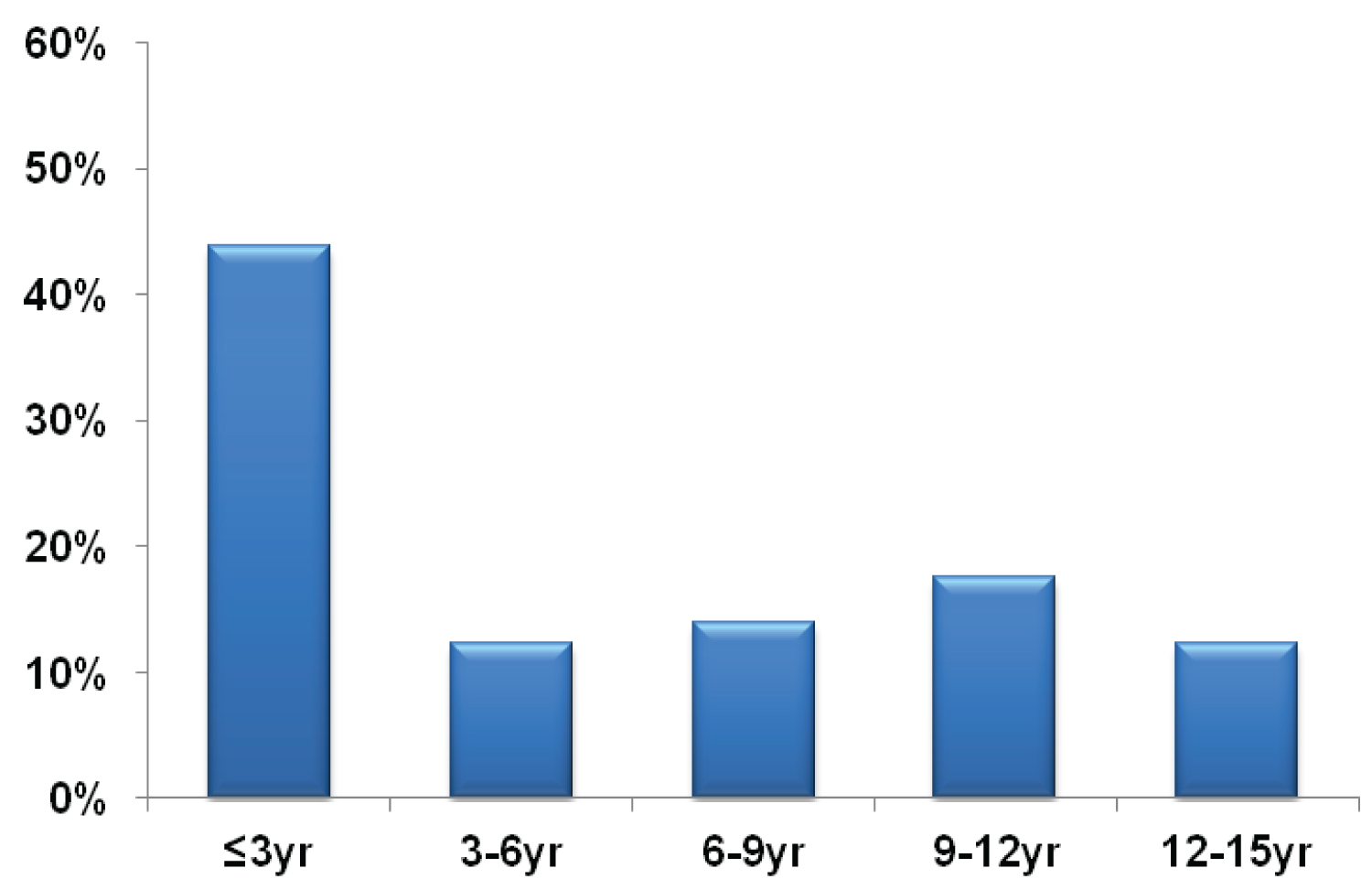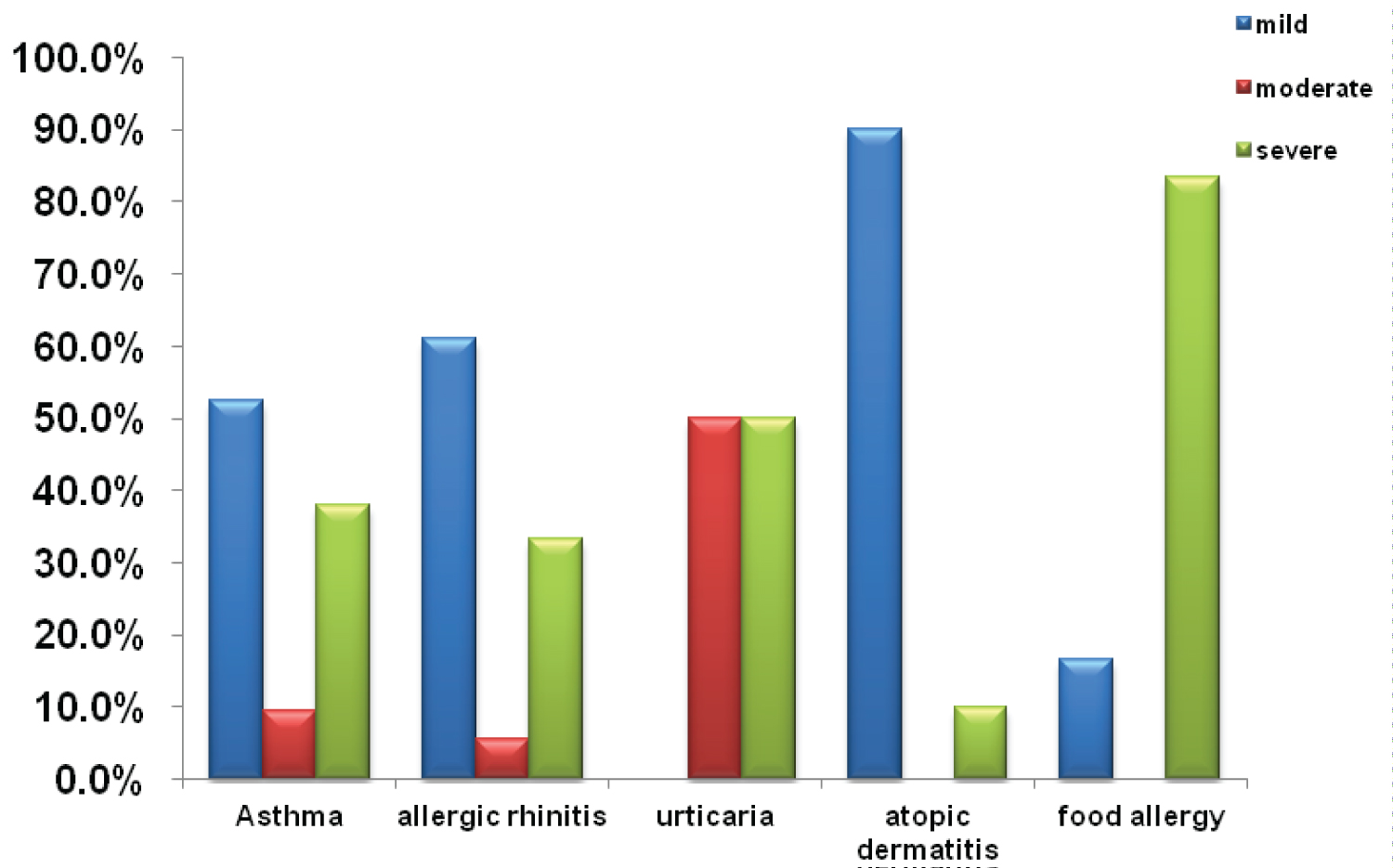Eosinophilic gastroenteritis is a chronic antigen mediated inflammatory disease that may occur in any part of the intestine, with a significant increase in the incidence in the last years. It might correlate to the increasing in atopic diseases.
An Observational Descriptive study (Case series) was conducted in 57 children with eosinophilic gastroenteritis. They are selected from Pediatric Gastroenterology Clinic, Tishreen University Hospital between September 2016 and September 2021.
A total of 57 children, 38 males (66.7%) and 19 females (33.3%) were included in the study. The median age was 5 years, and the most frequent age group was ≤ 3 year (43.9%). Growth failure (45.6%) and abdominal pain (29.8%) represented the most frequent clinical complaints. Many parts of the gastrointestinal tract were affected, and duodenum was the most affected part (63.2%), followed by duodenal bulb (8.8%), colon (5.3%), esophageal (3.5%), and stomach (3.5%). Family history of atopic diseases was present in 29.8% of the cases, especially in both parents (15.8%). The most common atopic features were asthma (36.8%) and allergic rhinitis (31.6%). Milk represented the most frequent food allergen (10.5%), which was diagnosed according to clinical history and food intolerance tests with presence of a significant correlation between food allergy and histological findings (p: 0.02). There were significant differences of the atopic features according to the age groups, in which asthma and allergic rhinitis diagnosed by physicians were more frequent in the older age, whereas other manifestations (urticaria, atopic dermatitis, and food allergy) were more frequent in the children younger than 3 years.
Eosinophilic gastroenteritis, Atopic, Children
Eosinophilic gastroenteritis is a chronic inflammatory process characterized by a combination of gastrointestinal complaints with infiltration by eosinophils that can affect different layers of the bowel wall. It has become an increasingly recognized condition in all ages since it was first described by Kaijser in 1937 [1,2].
The most common symptoms are colicky abdominal pain, diarrhea, weight loss, dysphagia, and vomiting. Children with eosinophilic gastroenteritis often have a concurrent or a history of atopic diseases, as well as a family history of atopy [3].
Prevalence of frequent atopic diseases such as atopic dermatitis, food allergy and asthma has increased substantially in the last decades in developed countries [4].
The pathophysiology is not well understood; however, it has been linked to overproduction of T-helper-2 cytokines (interleukin IL 13, 4, 5) which induce production of IgE and attraction of eosinophils [5]. Once eosinophils get recruited in the intestinal epithelium, they become cytotoxic by producing factors, such as major basic protein, neurotoxin and peroxidase [6,7].
Prior studies investigated the association between eosinophilic gastroenteritis and selected atopic disorders. Jensen, et al. (2016) showed that there was a high proportion of coexisting allergic conditions on average 38.5% for eosinophilic gastritis, 45.6% for gastroenteritis, and 41.8% for colitis, and allergic diseases were most frequent in pediatric patients [8]. Absences of local studies in Syria prompt us to carry out this study. Therefore, the aims of this study were: 1) To investigate atopic diseases in children with eosinophilic gastroenteritis; 2) Detecting presence of family history of atopy; 3) To evaluate the association between atopic features and histological findings.
After approval by local research ethics committee, the study was conducted in patients seen at Pediatric Gastroenterology Clinic, Tishreen University Hospital over a period of five years from September 2016 to September 2021 with a diagnosis of eosinophilic gastroenteritis.
Inclusion criteria were as follows: All children with a diagnosis of eosinophilic gastroenteritis depending on the histological findings of biopsies taken from the mucosa of the gastrointestinal tract during upper gastrointestinal endoscopy.
Exclusion criteria: Patients with other pathological etiologies that explain presence of eosinophilic infiltration (celiac disease, tumors, inflammatory bowel disease, parasites).
Complete history, review of systems, concurrent atopic diseases, physical examination, and upper gastrointestinal endoscopy were performed. Asthma was diagnosed based on clinical manifestations (cough, wheezing) and peak expiratory flow. Food allergy was diagnosed based on clinical history and food intolerance tests. Allergic rhinitis, urticaria and atopic dermatitis were diagnosed based on clinical history and physical examination. Patients were classified according to histological findings and eosinophilic count in high power field into: mild, moderate, and severe. The study included 57 patients after exclusion 3 patients with a diagnosis of: Celiac disease, Giardia lamblia infection, and Helicobacter pylori infection.
Statistical analysis was performed by using IBM SPSS version 20. Basic Descriptive statistics included means, standard deviations (SD), median, Frequency and percentages. To examine the relationships and comparisons between the two groups, Fisher's test was used. All the tests were considered significant at a 5% type I error rate (p < 0.05), β: 20%, and power of the study: 80%.
The study included a group of 57 children with eosinophilic gastroenteritis (38 males, 19 females). Ages range from 8 months to 14 years (the median age was 5 years). Patients were divided into five groups: ≤ 3 (43.9%), 3-6 (12.3%), 6-9 (14%), 9-12 (17.5%) and 12-15 (12.3%), (Figure 1).
 Figure 1: Distribution of the patients according to age groups.
View Figure 1
Figure 1: Distribution of the patients according to age groups.
View Figure 1
Patients had various clinical complaints, and the most common presenting symptoms included: growth failure (45.6%), followed by abdominal pain (29.8%), vomiting (10.5%), diarrhea (7%), lower gastrointestinal bleeding (5.3%), allergic symptoms (3.5%), constipation (3.5%), and anemia (1.8%). Family history of atopy was present in 15 patients (29.8%) represented by: parents (15.8%), mother alone (7%), father alone (3.5%), and both parents with brother or sister (3.5%) (Table 1).
Table 1: Demographic characteristics of the study population. View Table 1
As shown in Table 2, there are a varied range of atopic manifestations, and asthma is the predominant feature (36.8%), followed by allergic rhinitis (31.6%), atopic dermatitis (17.5%), food allergy (10.6%), and urticaria (7%). Duodenum was the most affected part of intestine (63.2%), with presence of gastroenteritis in multiple sites in 9 cases (15.8%).
Table 2: Distribution of the study population according to the atopic features and endoscopic features. View Table 2
The most common food allergens verified by food intolerance tests were: milk (10.5%), egg (5.3%), followed by fish, nuts, chocolate, peanuts, and soy on average 3.5% of each of them (Table 3).
Table 3: Food allergens for the study population. View Table 3
As shown in Table 4, there was a significant association between histological findings and food allergy in which 83.3% of the patients were with severe manifestations. There was no correlation between other atopic features with histological findings.
Table 4: Association between atopic features and histological findings. View Table 4
These findings were represented in the Figure 2.
 Figure 2: Association between atopic features and histological findings.
View Figure 2
Figure 2: Association between atopic features and histological findings.
View Figure 2
As shown in Table 5, asthma and allergic rhinitis were significantly more frequent in the older age groups (9-12 and 12-15 years), p < 0.05, whereas urticaria, atopic dermatitis, and food allergy were more frequent in the children younger than 3 years with statistical significant difference (p < 0.05).
Table 5: Association between atopic features and age groups. View Table 5
These findings were represented in the Figure 3.
 Figure 3: Association between atopic features and age groups.
View Figure 3
Figure 3: Association between atopic features and age groups.
View Figure 3
In the recent years, eosinophilic gastroenteritis has received increasing attention with the rise of incidence, which might be mainly due to early diagnosis. Understanding of the underlying factors that trigger this allergic inflammatory disease and taking preventive measures such as recognizing the most common food allergens and avoiding those foods when it is possible is essential to improve the final outcome.
This study showed the main findings. First, approximately two-third of the patients was males, and children younger than three years were the most frequent age group. Second, growth failure and abdominal pain were the main complaints. Third, 52.6% of the patients had one or more of atopic diseases, and asthma represented the most frequent disease, followed by allergic rhinitis due to asthma is the most frequent chronic disease in pediatric. These findings support the theory that eosinophilic gastroenteritis is mediated by T-helper 2, and absence of atopic diseases in other patients suggests presence of genetic, environmental, nutritional factors that contribute to morbidity. The results of current study are consistent with the previous studies.
Guajardo, et al. showed in a study conducted in 57 patients with eosinophilic gastroenteritis high incidence of asthma (39%), allergic rhinitis (63%), and eczema (40%). It may be explained by the high prevalence of atopy in developing countries [9].
Spergel, et al. found in a study included 620 patients with eosinophilic esophagitis presence of concurrent atopic diseases; asthma (50%), allergic rhinitis (61%), atopic dermatitis (21%), and food allergy (5.7%) [10].
Jensen, et al. demonstrated that atopic diseases were present in a varying percentages according to the site of disease in the gastrointestinal tract; eosinophilic gastritis (38.5%), gastroenteritis (45.6%), and colitis (41.8%). Allergic rhinitis was the most frequent atopic disease (30%) [8].
Limitations of this study were: limited number of patients, diagnosis of atopic disease depending on history taken by parents, and inability to perform total IgE analysis due to economic status in Syria.
The current study demonstrated that eosinophilic gastroenteritis is an emerging atopic disease that affect children, which might be explained by high rate of association between atopic diseases and eosinophilic gastroenteritis, presence of more than one concurrent atopic diseases in most children having eosinophilic gastroenteritis, the importance of family history of atopic diseases, histological findings of eosinophilia, and food allergy as a type of eosinophilic gastroenteritis disease.
A high suspicion of eosinophilic gastroenteritis is warranted in children with gastrointestinal symptoms and associated atopic disorders, in which early diagnosis by performing gastroendoscopy with taking biopsies and early management might improve the outcome. We emphasize the importance of monitoring eosinophilic gastroenteritis patients by both allergist and gastroenterologist.
All the authors do not have any possible conflicts of interest.
After discussing the study with the parents, all of them gave a complete and clear informed consent to participate in the study. This study was performed in accordance with the Declaration of Helsinki.
Most of the data was in the article, and other data can be asked from the corresponding author.
Not applicable.
All authors performed the measurements and wrote the article. Literature review was done by Dr. Reman Ali Ali, and all authors performed analytic calculations.
We wish to thank all doctors in the pediatric department.